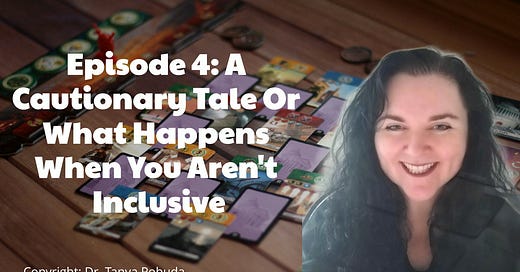My motivation to do this research comes from a place of both curiosity, concern, and, again, a sense of urgency. I understand from decades of experience in the corporate world, business leaders really privilege numeracy more than stories, and this understanding informs my research design detailed in chapter three. I have been enculturated in my years of working with business leaders to speak the language of money, of marketing, of neoliberal tactics to extract revenue from customer bases to create value for shareholders. In this endeavour, I am attempting, at least partially, to speak to the money behind board games. This research is designed to inform large publishers and their financial backers about how representation, diversity and inclusion is a serious risk management challenge for their future growth.
As a former tech reporter, I see parallels between board gaming and the early days of the personal computing industry. In the early 90s, I worked as a reporter and later, a communication advisor to technology companies in Canada and the U.S. One very well-known company, today part of the so-called Frightful Five (Facebook, Amazon, Google, Microsoft, and Apple) had a corporate performance model that was focused almost entirely on market expansion. When I did work for this company, I experienced first-hand how doggedly focused this technology giant was on expanding out from its beachhead market of white, male middle-class 'early adopters'. This company’s entire goal was to create interest in personal computing amongst different demographies, and walks of life, from kids, moms, and grandparents to specific industry sectors who could benefit from automation. This tech giant worked to create computing literacies and expand its addressable market for computing software and hardware, driving up broad-based interest in personal computing. This company spent the lion’s share of its marketing budget relentlessly driving expansion initiatives and wooing new users. This technology leader gave stuff away, held computing literacy workshops, and hired personal computing evangelists to roam Canada and the U.S. winning friends and influencing people in untapped, underrepresented communities, and market segments. This company now runs workshops on cruise ships and retirement communities to provide computing literacy to ageing users. This strategy worked. This client thrived and grew into a titan of the global marketplace.
However, this was not the fate of another technology client of mine. This ill-fated hardware and software company no longer exists: its technologies were subsumed through acquisition by another hardware company, which, in turn, also no longer exists. The client that failed was infamous for its technical elitism, focusing on a small pool of scientific and technical users, to the exclusion of any other markets. This client even had a president who said,"(t)here is no reason for any individual to have a computer in his home" (Bracetti, 2013). There was an elitism that pervaded the ranks of this organization, one arguably rooted in a gendered and racialized understanding of their marketplace. They thought that spending any time on expanding their base was a waste of time and resources. I both see and hear a similar kind of blinkered, elitist view, grounded in myths about gender and race, in corners of the board game market. There’s a focus on an imagined audience of ‘real gamers’ and the ‘real addressable market’ that seems to be rooted in a familiar sounding elitism, the same lack of imagination about addressable markets. It was these same discourses and debates that pervaded the early days of personal computing within some of the companies that didn’t survive. While the companies looked out beyond their comfortable and familiar base of users, and cultivated broader audiences, they did not only just survive but they thrived.
Lastly, on the subject of self-disclosure and motivation, I love games. I need games. As my friends and family have often noted, I am a fervent board game evangelist. I hand out board games to those I care about like a kind of medicine. Indeed, I believe games are medicine. I believe we all need games for a variety of reasons, from education, to enhancing an understanding of how to look at and solve complex problems, to offering a way to engage with others, providing a means to communicate complex ideas, and tell human narratives in a way that helps people live through, and truly feel these stories. I am an obsessive collector of board games, and a long-time gamer. Prior to the pandemic, you could find me in any number of friendly local games stores (FLGSs) around Toronto several times a week. I am a member of online board game forums such as r/boardgames on Reddit, and of course, Twitter. In game stores, in board game meet ups, and online I have experienced some of the problematic behaviours detailed by women, non-binary, LGBTQiIA+, and BIPOC people who have come forward to share their stories in this research. On my weekly trek to buy Magic: The Gathering cards to a store with a, shall we say?, difficult reputation, I was regularly corrected, dismissed or ignored outright as I attempted to make purchases. At board gaming meetups, it is my partner, who identifies as a man who is addressed and spoken to when I make a comment or ask a question. I’ve been ignored, talked over, and insulted. I’m frequently interrogated by members of the board gaming community in an effort to have me ‘prove’ my knowledge or ‘nerd cred’ when it comes to games. Once, when describing a board game design project, I was working on, a close acquaintance in the board gaming community blurted out, “You’ve designed a game? What is it ...a roll-and-move?” The remark was meant as an insult, as roll-and-move games are considered childish and unserious games within the hobby community (a notion that is another form of gatekeeping in and of itself). I’ve had academic colleagues tell me this specific research exercise is “meaningless”, adding that (and this is a true story) “they are just games ...of course they have pictures of women with their boobs out!”
As noted earlier, I’ve received online hate and threats for the work I am doing. I’ve seen long-time members of board game groups leave their online communities simply because someone shared my earlier 2018 study. I’ve heard the line, “keep your politics out of my games” more times than I can count. To this, I say: I can’t, and I won’t, because to do so is an impossibility. Games are political, and the labour of game design is political, as I will discuss in greater depth in chapter two. I know that this work, along with other quantitative and qualitative feminist media analyses, are critically important endeavours as we, as a culture, seek to create a more perfect, just and cohesive society, and arc the course of the moral universe toward justice. I believe a systemic lack of equity and inclusion in society, business spaces, and cultural practices limits human progress, blocks innovation, prevents growth, subjects people to a variety of indignities, and ultimately, harms and kills people. I believe with everything that I am that a culture that blocks or denies the full inclusion of all people is a culture that prevents human flourishing, and is corrupt at its core. All of this has spurred me on to ask the questions posed by this research endeavour.
State of Play: Why is Board Gaming So White and Male?
problems caused by a lack of equity, diversity and inclusion, driving an ever-louder chorus of voices in the board game enthusiast community to call for change. A lack of representation in board game production, inclusion in gaming spaces, and an absent diversity of themes, characters and stories told by board games has stunted the potential growth of board games (Sheldon, 2016; Hova, 2014; Davis, 2013). Vocal participants in board gaming have called for board games to be made for a wider demographic of players, and for the industry to open more opportunities for women, and BIPOC creators (Teague, 2016; Pobuda, 2018; Davis, 2013; Howe, 2019, Huber, 2016; Rosewater, 2019). Despite the growing popularity of analog games, there exists a significant gender and racial imbalance in the labour of board games creation, and a gender and racial imbalance in the hobbyist community (Pobuda, 2018; Boycott-Owen, 2018; Arnaudo, 2017; Donovan, 2017; Teague, 2016). This research effort seeks to fill the gap in academic scholarship on the representation of women, and BIPOC inclusion and diversity in both the gaming industry and in the spaces where board gaming is practiced. The gendered labour of board game production, and the gender and racial gap in board game design and artwork, I will argue, creates a vicious circle of exclusion and delimits the wider adoption of this cultural practice (Teague, 2016; Pobuda, 2018; Davis, 2013; Howe, 2019, Huber, 2016; Rosewater, 2019).
Some commentators have argued that a renewed mainstream interest in board games is due to an intergenerational cultural yearning for face-to-face interaction in a play activity that recalls time before smartphones (Arnaudo, 2017; Donovan, 2017; Pilon, 2016). Board gaming has become a pastime that is enjoying increased attention and active cultural practice; however, the nostalgia associated with board games, tied as it is with idealizations of a ‘simpler’ (read: less complicated, more homogenous, less diverse) time comes with sociocultural baggage (Teague, 2016; Arnaudo, 2017; Donovan, 2017; Pilon, 2016).
Mass market and hobby board games have often relied on a narrow spectrum of themes, game mechanics, and imagery, agricultural vistas inhabited by blonde-haired, blue-eyed farmers, the “Eurocentric lore” of knights fighting orcish hordes, Vikings pillaging coastal villages, or sprawling mercantile or imperial empires (Howe, 2019, n.p., Huber, 2016; Rosewater, 2019). Over the past 40 years, popular board games have often been heavily reliant on literary properties such as Tolkien’s Lord of the Rings (LOR) trilogy, with at least 229 or more unique board game titles, game expansions and LOR-themed game products based on the Tolkien universe (BGG, LOR, 2020). As with these literary, cinema and television properties, the games are dominated by mainly white male protagonists styled in the same fashion as literary and filmic variants of Campbell’s monomyth; these overwhelmingly white male heroes alone have heroic traits and agency to conquer obstacles, slay the monsters, claim the treasure and of course, rescue the damsel in distress (Campbell, 2003). Like the traditional tropes and themes of these intellectual properties, the board game publishing industry, some have argued, is mired in a recursive, regressive, and white male-dominated past (Teague, 2016; Pobuda, 2018: Sheldon, 2016; Ryan, 2016; Davis, 2013; Howe, 2019, Huber, 2016; Rosewater, 2019).
There is a demographic shift happening in gaming, with some observers noting that in digital gaming is now achieved parity between those who identify as women and those who identify as men (Teague, 2016). An increasing number of studies demonstrate that women are fast becoming a dominant demographic segment in digital gaming. Women currently represent 46 per cent of gamers in the U.S., a number that continues to rise (Gough, 2019). Recent digital gamer studies tell us that video gaming is increasingly pervasive and mainstream in the U.S. with 64 percent of U.S. households containing a device used to play video games; adult women players represent 33 percent of all U.S. gamers and in fact, outnumber males under 18 years of age which represent 17 percent of all gamers (ESAC, 2018). Another study found that women made up 46 percent of the digital and video gaming community in the U.S. in 2019, an increase over 2017 up 4 percentage points (Statista, 2019). Pew Research (2017) found that 24 percent of Black respondents reported playing video games often and 21 percent reported playing them sometimes; 18 percent of Hispanics reported playing often and 29 percent reported playing sometimes. In Canada, the average age of self-reported gamers is 39 years old, with the demographic split evenly between those who identify as male and female (ESAC, 2018).
Behind these numbers is a more expansive definition of what is now considered a digital game with the rise of the so-called “casual revolution” (Juul, 2010) which recognizes the inclusion of quick-play mobile games that integrate into daily living more seamlessly than the more traditionally recognized games, such as first-person shooters (FPSs) and open world sandbox role-playing games geared towards the so-called hardcore category of gamers. Juul (2010) plotted the trajectory of video games from the arcade beginnings where all were welcome to enjoy these early games’ casual welcome, to a time when the video game industry became increasingly commercialized, and the imagined of audience of mostly white male hardcore gamers hardened and calcified. But as Juul (2010) notes, gaming could not stay stuck in the so-called hardcore valley for long, and a shift to a new casual revolution opened up video gaming to an increasingly wider and wider audience.
While academic peer-reviewed demographic studies for digital game players abound, recent surveys of analog gamers are often informal, conducted by games publishers, or enthusiasts outside of peer-reviewed, scholarly processes. As a researcher in the field of digital and board games, I’ve often heard the argument that women, specifically, simply do not play board games, or certainly do not play them with any regularity. This is a talking point I’ve encountered while browsing through posts on r/boardgames on Reddit or on Twitter. If one were to look at available demographic studies conducted by hobbyist sites and enthusiasts, that argument, that women don't play board games with any regularity, might be lent some significant credence. The numbers of self-reported board game fans among women, BIPOC and other marginalized groups remains quite low in these hobbyist studies.
A 2019 board gaming study conducted by Meeple Mountain, a board game enthusiast site, found that 69 per cent of those who filled out the online survey identified as men; 27 per cent identified as women and 0.02 per cent identified as non-binary (Booth, 2019). Publisher Stonemaier Games (2017) conducted a demographic survey that elicited 3,427 responses among the publisher’s subscribers (reported to be 30,437 in total) found 91.7 percent of respondents were men and 8.1 percent were women; in 2019, the number of women subscribers rose to 17.9 percent with 81.1 percent identifying as men (Stonemaier, 2017, 2019). The website Daily Worker Placement (2016) published the results of a 2016 demographic survey of 2,397 respondents that found 24 percent of board gamers were women, 1.1 percent nonbinary and 0.6 percent were trans, leaving the remainder - the majority at 74.3 percent - identifying as male. The overwhelming majority of survey respondents were also white, with the Daily Worker Placement (2016) survey reporting that only 2.1 percent of respondents were Chinese, that 2.7 percent were Latin American, 0.6 percent were Aboriginal, and 0.7 percent were Filipino. Booth (2021) noted that only 89 respondents to a survey of 837 participants for his book Board Games as Media were BIPOC or a little under 11 percent; another survey conducted by Booth (2021) garnered respondents who identified as women at 27 percent. Some of these surveys might be challenged by issues involving limited promotions, a fear over a lack of anonymity, or a feeling that information might be used to try and sell something to the participants. These kinds of surveys might also only attract a small pool of participants who already have an existing relationship with the publisher or publication. As such, they can only give us an imperfect glimpse into the true picture of women, BIPOC and LGBTQiIA+ participation in board gaming.












Share this post